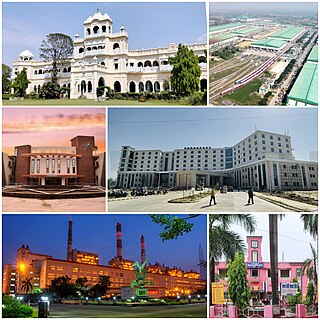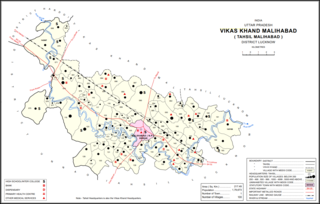
Lucknow is the capital and the largest city of the Indian state of Uttar Pradesh and it is the administrative headquarters of the eponymous district and division. Having a population of 2.8 million as per 2011 census, it is the eleventh most populous city and the twelfth-most populous urban agglomeration of India. Lucknow has always been a multicultural city that flourished as a North Indian cultural and artistic hub, and the seat of power of Nawabs in the 18th and 19th centuries. It continues to be an important centre of governance, administration, education, commerce, aerospace, finance, pharmaceuticals, information technology, design, culture, tourism, music, and poetry.

Etawah, also known as Ishtikapuri, is a city on the banks of Yamuna River in the state of Western Uttar Pradesh in India. It is the administrative headquarters of Etawah District. Etawah's population of 256,838 makes it the 180th most populous city in India. The city lies 300 km (190 mi) southeast of the national capital New Delhi, 230 km (140 mi) northwest of the state capital Lucknow, 120 km east of Agra and 140 km west of Kanpur. The city was an important centre for the Indian Rebellion of 1857. It is also the sangam or confluence of the Yamuna and Chambal rivers. It is the 26th most populous city in Uttar Pradesh.

Faizabad is a city located in Ayodhya district in the Indian state of Uttar Pradesh. It is situated on the southern bank of the River Saryu about 6.5 km from Ayodhya City, the district headquarter, 130 km east of the state capital Lucknow. Faizabad was the first capital of the Nawabs of Awadh and has monuments built by those Nawabs, like the Tomb of Bahu Begum, Gulab Bari. It was also the headquarters of Faizabad district and Faizabad division before November 2018. Faizabad is a twin city of Ayodhya and it is administered by Ayodhya Municipal Corporation.

Shahjahanpur is a municipal corporation, town and district headquarters of Shahjahanpur District in Western Uttar Pradesh, India.
Lal Bihari is an Indian farmer and activist from Amilo, in Azamgarh district, Uttar Pradesh, who, though alive, was officially designated dead between 1975 and 1994. He fought with Indian bureaucracy for 19 years to prove that he was alive. Meanwhile, he added Mritak (transl. deceased) to his name, and founded Mritak Sangh, the Uttar Pradesh Association of Dead People, to highlight other cases like his.

Narayan Datt Tiwari was an Indian politician who served as the 9th Chief Minister of Uttar Pradesh and 3rd Chief Minister of Uttarakhand from 2002 to 2007. He was first Indian Chief Minister who served for two states. He formerly in the Praja Socialist Party and later joined the Indian National Congress.

Raebareli is a city in Indian state of Uttar Pradesh. It is the administrative headquarters of Raebareli district and a part of Lucknow Division. The city is situated on the banks of the Sai river, 82 km (51 mi) southeast of Lucknow. It possesses many architectural features and sites, chief of which is a strong and spacious fort. As of 2011, Raebareli had a population of 191,316 people, in 35,197 households.

Barabanki district is one of the five districts of Ayodhya division in the central Awadh region of Uttar Pradesh, India. Barabanki city is the administrative headquarters of Barabanki district. Total area of Barabanki district is 3891.5 Sq. km.

Lucknow district is a district located in the state of Uttar Pradesh in northern India. The city of Lucknow is the district headquarters and the district is part of Lucknow Division. It is also the capital city of Uttar Pradesh. Lucknow is bounded on the east by Barabanki district, on the west by Unnao and Hardoi districts, on the south by Raebareli district and in the north by Sitapur district.

Raebareli district is a district of Uttar Pradesh state in northern India. The city of Raebareli is the district headquarters. This district is a part of Lucknow Division in Uttar Pradesh state. The total area of Raebareli district is 3,371 Sq. km.

Farrukhabad district is a district of Uttar Pradesh state of India. The town of Fatehgarh is the district headquarters. The district is part of Kanpur Division.

Ram Prasad Bismil was an Indian poet, writer, and revolutionary who fought against British Raj, participating in the Mainpuri Conspiracy of 1918, and the Kakori Conspiracy of 1925. He composed in Urdu and Hindi under pen names Ram, Agyat and Bismil, becoming widely known under the latter. He was also a translator.

Kakori is a town and a nagar panchayat in Lucknow district in the Indian state of Uttar Pradesh, 19 km North of Lucknow city centre. Kakori was a centre for Urdu poetry, literature and the Qadiriya Qalandari Sufi order. On 9 August 1925, Indian revolutionaries robbed a train of government funds in Kakori, an incident known as the Kakori Train robbery.

Malihabad is a town and nagar panchayat in the Lucknow district of Uttar Pradesh, India. It is also the seat of a tehsil and a community development block of the same name. As of 2011, its population was 17,818, in 3,032 households. Malihabad is the largest of Uttar Pradesh's 14 designated mango belts and accounted for 12.5% of all mango production in the state in 2013. Hundreds of mango varieties are grown here, including the Chausa, Langda, Safeda, and most famously the Dasheri, the "king of mangoes" of which it is one of India's main producers and exporters. Mango grower and Padma Shri recipient Haji Kaleem Ullah Khan has contributed to the popularization of Malihabad's mango industry.

Uttar Pradesh is the most populous state in India with a population of nearly 240 million people. The economy of Uttar Pradesh is the fifth largest among states in India. At current prices, the gross state domestic product (GSDP) of Uttar Pradesh is estimated to be ₹24.39 lakh crore (US$310 billion) in 2023–24. Merchandise exports from Uttar Pradesh reached US$21.03 billion in FY22.
Awadhi cuisine is a cuisine native to the Awadh region in Northern India and Southern Nepal. The cooking patterns of Lucknow are similar to those of Central Asia, the Middle East, and Northern India and western India with the cuisine comprising both vegetarian and non-vegetarian dishes. The Awadh region has been influenced by Mughal cooking techniques, and the cuisine of Lucknow bears similarities to those of Central Asia, Kashmir, Punjab and Hyderabad. The city is also known for its Nawabi foods.

Kasmandi Kalan is a Village in Malihabad block of Lucknow district, Uttar Pradesh, India. It is located 27 km away from central Lucknow, a short distance to the north of the Behta River. The village lands include two settlements, Kasmandi Kalan proper in the north and the hamlet of Hafiznagar to the south. Historically known as a Muslim centre, Kasmandi Kalan is renowned for its mango orchards and is surrounded by mango trees all around. Some mango groves here are very old, dating back to the time of the Nawabs of Awadh.

Fatehpur District is one of the 75 districts of the Indian state of Uttar Pradesh. The district has a population of 2,632,733. Fatehpur city is its administrative headquarters.
Kakori railway station is a small railway station in Lucknow district, Uttar Pradesh. Its code is KKJ. It serves Kakori village.

Anwar Ratol is a small, yellow variety of mango known for its sweetness and fiberlessness. It is sometimes called the 'mini powerhouse'. It is cultivated in the Punjab and Sindh regions of Pakistan, and near the village of Rataul in Uttar Pradesh, India. It is very sweet in taste with less fiber.




















